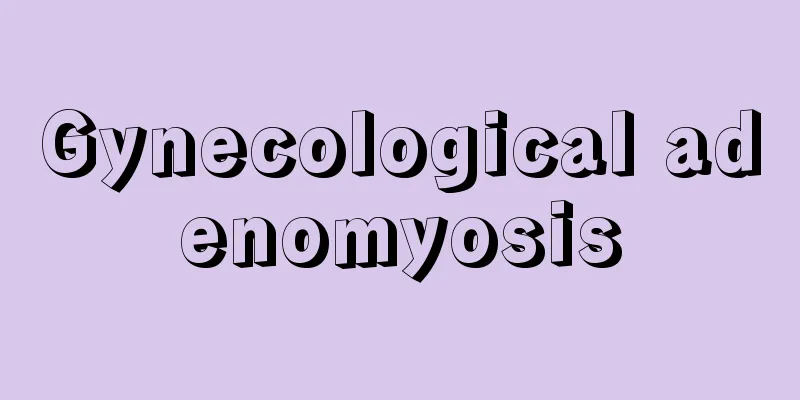Gynecological adenomyosis

|
Gynecological adenomyosis is a common disease in women. It is caused by abnormalities or lesions in the uterine tissue and the muscle layer inside the uterus. Suffering from gynecological adenomyosis will not only endanger physical health, but also easily affect normal fertility. It can be treated with surgery, which needs to be performed according to the severity of the disease. How should gynecological adenomyosis be treated? There are many treatments for gynecological adenomyosis, and different treatment methods can be chosen according to the patient's age, condition, and fertility requirements. Patients with mild symptoms can use medication for symptomatic treatment, while those with severe symptoms can undergo surgery. Hysterectomy is a radical surgery for women who do not desire to have children. Cause Analysis The cause of gynecological adenomyosis has not yet been fully clarified. It is currently believed that it may be closely related to the imbalance of women's endocrine hormone levels. Suggested actions It is recommended to go to the hospital for relevant examinations in time and follow the doctor's advice for standardized treatment. Pay attention to a light diet and avoid spicy food. Adenomyosis is a disease in which endometrial glands and stroma invade the myometrium to form diffuse or localized lesions. Like endometriosis, it is a common and difficult gynecological disease. Adenomyosis mostly occurs in multiparous women around 30 to 50 years old, but it can also be seen in young nulliparous women. This may be related to the increase in various intrauterine operations. About 15% of patients have concomitant endometriosis, and about 50% have concomitant uterine fibroids. The disease can be treated with drug intervention or surgical treatment, but it is difficult to cure it. Only after menopause can the patient's adenomyosis gradually improve on its own. Therefore, the choice of clinical treatment plan needs to be individualized based on the patient's age, symptoms and fertility requirements. treat There are many treatment options for this disease, and clinical decisions need to be individualized based on the patient's age, symptoms, and fertility requirements. Surgery and drug treatment options can be chosen at the same time. 1. Drug treatment (1) Symptomatic treatment: For patients with mild symptoms who only require relief of dysmenorrhea, nonsteroidal anti-inflammatory drugs such as ibuprofen, indomethacin or naproxen can be used for symptomatic treatment during dysmenorrhea. (2) Pseudopregnancy therapy is used for patients with mild symptoms, no desire to have children, and those near menopause. Oral contraceptives or progestins can cause the ectopic endometrium to decidualize and atrophy, thereby controlling the development of adenomyosis. (3) For women with heavy menstrual flow, dysmenorrhea, and no desire to have children, an intrauterine device containing highly effective progestin can be chosen. It continuously releases progestin locally in the uterus to control the development of ectopic lesions and needs to be removed or replaced after five years. (4) Pseudomenopause therapy ("medical oophorectomy" or "medical hypophysectomy"): drugs that shrink the lesions before surgery and reduce recurrence after surgery. GnRHa injection makes the hormone level in the body reach the menopausal state, thereby causing the ectopic endometrium to gradually atrophy and play a therapeutic role. The application of GnRHa can significantly reduce the size of the uterus and can be used as a preoperative medication for some patients with larger lesions and difficult surgeries. If you wait until the uterus becomes smaller before performing surgery, the risks and difficulty will be significantly reduced. Side effects may cause menopausal symptoms and even serious cardiovascular and cerebrovascular complications and osteoporosis. Therefore, it is recommended to add estrogen in reverse after 3 months of GnRHa application to alleviate complications. In addition, GnRHa is expensive, so it is not currently used as a long-term treatment option. Once the drug is stopped, the resumption of menstruation may lead to further progression of the disease. |
<<: How to successfully conceive
>>: Will there be watery leucorrhea during ovulation?
Recommend
Teach you the most suitable breast beauty yoga in spring
Speaking of spring, it’s a beautiful season! The ...
Can I perm my hair during pregnancy?
Pregnancy and childbirth are major life events th...
There is a cyst on the right ovary
If a woman has a cyst on her right ovary, it gene...
Beware! These urine abnormalities may be a sign of cancer!
Many people may not notice some subtle difference...
Will eating red beans during breastfeeding reduce milk production?
Red beans have the effect of nourishing blood and...
What's the matter with brown discharge two months after delivery?
Women after childbirth will have an extremely imp...
Hypoechoic breast nodules Bi-Rads3
Is birads3 breast mass serious? How to treat grad...
What is the cause of the rotten roots of Gloxinia flowers? How to save Gloxinia flowers after they have rotten roots?
Gloxinia flowers are a common flower plant in lif...
What should girls do if they have sweaty feet? This is the effective method!
For female friends, athlete's foot is an extr...
Symptoms of brain cancer in women
In recent years, with the increase in the inciden...
What medicine is used for vaginal itching
Vaginal itching is generally caused by bacterial ...
There are several types of girls' personalities
Every girl has a different personality. Girls sho...
Is cervical cyst surgery painful?
What people often call cervical cysts actually re...
What does the disappearance of the cervical canal indicate?
First of all, I want to tell you about the functi...
What causes tinnitus during pregnancy?
After pregnancy, there will be some pregnancy rea...









